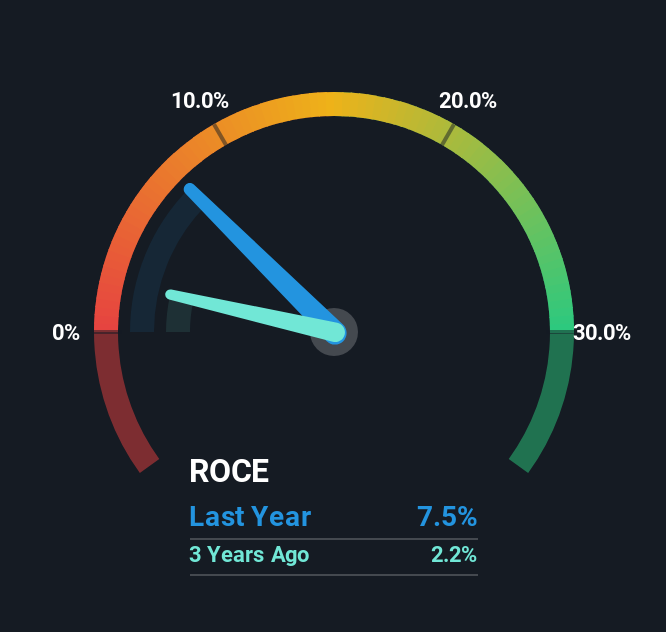- South Korea
- /
- Aerospace & Defense
- /
- KOSE:A047810
Korea Aerospace Industries (KRX:047810) Is Reinvesting At Lower Rates Of Return
Finding a business that has the potential to grow substantially is not easy, but it is possible if we look at a few key financial metrics. One common approach is to try and find a company with returns on capital employed (ROCE) that are increasing, in conjunction with a growing amount of capital employed. Put simply, these types of businesses are compounding machines, meaning they are continually reinvesting their earnings at ever-higher rates of return. Although, when we looked at Korea Aerospace Industries (KRX:047810), it didn't seem to tick all of these boxes.
What Is Return On Capital Employed (ROCE)?
If you haven't worked with ROCE before, it measures the 'return' (pre-tax profit) a company generates from capital employed in its business. The formula for this calculation on Korea Aerospace Industries is:
Return on Capital Employed = Earnings Before Interest and Tax (EBIT) ÷ (Total Assets - Current Liabilities)
0.075 = ₩250b ÷ (₩9.4t - ₩6.0t) (Based on the trailing twelve months to June 2025).
So, Korea Aerospace Industries has an ROCE of 7.5%. On its own that's a low return on capital but it's in line with the industry's average returns of 7.5%.
See our latest analysis for Korea Aerospace Industries

Above you can see how the current ROCE for Korea Aerospace Industries compares to its prior returns on capital, but there's only so much you can tell from the past. If you'd like to see what analysts are forecasting going forward, you should check out our free analyst report for Korea Aerospace Industries .
How Are Returns Trending?
When we looked at the ROCE trend at Korea Aerospace Industries, we didn't gain much confidence. To be more specific, ROCE has fallen from 11% over the last five years. Given the business is employing more capital while revenue has slipped, this is a bit concerning. If this were to continue, you might be looking at a company that is trying to reinvest for growth but is actually losing market share since sales haven't increased.
On a separate but related note, it's important to know that Korea Aerospace Industries has a current liabilities to total assets ratio of 64%, which we'd consider pretty high. This can bring about some risks because the company is basically operating with a rather large reliance on its suppliers or other sorts of short-term creditors. Ideally we'd like to see this reduce as that would mean fewer obligations bearing risks.
Our Take On Korea Aerospace Industries' ROCE
In summary, we're somewhat concerned by Korea Aerospace Industries' diminishing returns on increasing amounts of capital. The market must be rosy on the stock's future because even though the underlying trends aren't too encouraging, the stock has soared 371%. Regardless, we don't feel too comfortable with the fundamentals so we'd be steering clear of this stock for now.
Like most companies, Korea Aerospace Industries does come with some risks, and we've found 2 warning signs that you should be aware of.
If you want to search for solid companies with great earnings, check out this free list of companies with good balance sheets and impressive returns on equity.
Valuation is complex, but we're here to simplify it.
Discover if Korea Aerospace Industries might be undervalued or overvalued with our detailed analysis, featuring fair value estimates, potential risks, dividends, insider trades, and its financial condition.
Access Free AnalysisHave feedback on this article? Concerned about the content? Get in touch with us directly. Alternatively, email editorial-team (at) simplywallst.com.
This article by Simply Wall St is general in nature. We provide commentary based on historical data and analyst forecasts only using an unbiased methodology and our articles are not intended to be financial advice. It does not constitute a recommendation to buy or sell any stock, and does not take account of your objectives, or your financial situation. We aim to bring you long-term focused analysis driven by fundamental data. Note that our analysis may not factor in the latest price-sensitive company announcements or qualitative material. Simply Wall St has no position in any stocks mentioned.
About KOSE:A047810
Korea Aerospace Industries
Manufactures and sells fixed and rotary wing aircrafts, and airframe products in South Korea.
High growth potential with mediocre balance sheet.
Similar Companies
Market Insights
Community Narratives



